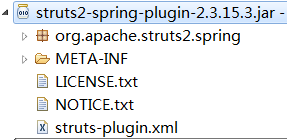关于整合ssh中的细节03
关于spring中提供的一些工具类和监听介绍
一、spring提供了一个HibernateTemplate类
①HibernateTemplate类:
用于操作PO对象,类似Hibernate Session对象。这个是整合的一个小变化,底层用的还是session但是他将读取配置文件的事情交给了这个类;来操作
这个类里面的方法和session里面的方法十分相似,所以整合时我们常常会使用这个类!
- public class UserDaoImpl implements UserDao {
- //需要spring注入模板
- private HibernateTemplate hibernateTemplate;
- public void setHibernateTemplate(HibernateTemplate hibernateTemplate) {
- this.hibernateTemplate = hibernateTemplate;
- }
- @Override
- public void save(User user) {
- this.hibernateTemplate.save(user);
- }
- }
②HibernateDaoSupport类
HibernateDaoSupport类是用来简化上面的操作,上面的HibernateTemplate这个类的实例需要我们手动去spring中注入。而HibernateDaoSupport类中已经包含了创建HibernateTemplate的代码,我们只需要继承这个类然后只需要去注入SessionFactory即可
- <!-- 3 dao -->
- <bean id="userDao" class="com.itheima.dao.impl.UserDaoImpl">
- <property name="sessionFactory" ref="sessionFactory"></property>
- </bean>
③如果删除hibernate.cfg.xml配置文件怎么去配置hibernate所需要的东西
在spring中有相应的配置来配置hibernate所需要的东西。如下代码,我们使用特殊的LocalSessionFactoryBean来创建特殊的bean,使用这个类我们创建出SessionFactory
然后在SessionFactory里面配置我们hibernate中所需要的配置!
- <!-- 1.3配置 LocalSessionFactoryBean,获得SessionFactory
- * configLocation确定配置文件位置
- <property name="configLocation" value="classpath:hibernate.cfg.xml"></property>
- 1)dataSource 数据源
- 2)hibernateProperties hibernate其他配置项
- 3) 导入映射文件
- mappingLocations ,确定映射文件位置,需要“classpath:” ,支持通配符 【】
- <property name="mappingLocations" value="classpath:com/itheima/domain/User.hbm.xml"></property>
- <property name="mappingLocations" value="classpath:com/itheima/domain/*.hbm.xml"></property>
- mappingResources ,加载执行映射文件,从src下开始 。不支持通配符*
- <property name="mappingResources" value="com/itheima/domain/User.hbm.xml"></property>
- mappingDirectoryLocations ,加载指定目录下的,所有配置文件
- <property name="mappingDirectoryLocations" value="classpath:com/itheima/domain/"></property>
- mappingJarLocations , 从jar包中获得映射文件
- -->
- <bean id="sessionFactory" class="org.springframework.orm.hibernate3.LocalSessionFactoryBean">
- <property name="dataSource" ref="dataSource"></property>
- <property name="hibernateProperties">
- <props>
- <prop key="hibernate.dialect">org.hibernate.dialect.MySQL5Dialect</prop>
- <prop key="hibernate.show_sql">true</prop>
- <prop key="hibernate.format_sql">true</prop>
- <prop key="hibernate.hbm2ddl.auto">update</prop>
- <prop key="hibernate.current_session_context_class">thread</prop>
- </props>
- </property>
- <property name="mappingLocations" value="classpath:com/itheima/domain/*.hbm.xml"></property>
- </bean>
二、spring中关于struts的整合
整合struts只有两种方式:
①在spring中使用IOC来给Action动作类中注入UserService的实例
- <!-- 6 配置action -->
- <bean id="userAction" class="com.itheima.web.action.UserAction" scope="prototype">
- <property name="userService" ref="userService"></property>
- </bean>
然后对应着struts.xml配置中指定动作类
- <struts>
- <!-- 开发模式 -->
- <constant name="struts.devMode" value="true" />
- <package name="default" namespace="/" extends="struts-default">
- <!-- 底层自动从spring容器中通过名称获得内容, getBean("userAction") -->
- <action name="userAction_*" class="userAction" method="{1}">
- <result name="success">/messag.jsp</result>
- </action>
- </package>
②我们不在spring中注入UserService的实例。(那问题来了,谁给我们创建UserService的实例,不实例化则不能使用其对象方法)
如图可看见struts.xml还是按照正常的方式编写
- <package name="default" namespace="/" extends="struts-default">
- <!-- 底层自动从spring容器中通过名称获得内容, getBean("userAction") -->
- <action name="userAction_*" class="com.itheima.web.action.UserAction" method="{1}">
- <result name="success">/messag.jsp</result>
那么谁给注入UserService的实例呢?
分析:
1. struts 配置文件
default.properties ,常量配置文件
struts-default.xml ,默认核心配置文件
struts-plugins.xml ,插件配置文件
struts.xml,自定义核心配置文件
常量的使用,后面配置项,将覆盖前面的。
2.default.properties ,此配置文件中确定 按照【名称】自动注入
/org/apache/struts2/default.properties

3.当整合struts-plugins.xml ,struts整合spring

<constant name="struts.objectFactory" value="spring" />
struts的action将由spring创建
但前提是:Action类中,必须提供service名称与 spring配置文件一致。(如果名称一样,将自动注入)

总结,之后action有spring创建,并按照名称自动注入
三、如何使spring整合到web项目中
当项目创建时我们想要它在请求前加载完成spring的配置文件
又想要在项目之后创建,则我们可以想到配置web.xml
spring提供了一个监听器ContextLoaderListener上下问加载监听器,当服务器启动时会加载web.xml则这个监听也将会被加载,但是这个监听默认指向的是WEB-INF下所以我们还需要配置指定路径classpath:applicationContext.xml,这样当服务启动后就会加载spring的配置文件
web.xml配置
- <!-- 1 确定spring xml位置 -->
- <context-param>
- <param-name>contextConfigLocation</param-name>
- <param-value>classpath:applicationContext.xml</param-value>
- </context-param>
- <!-- 2 spring监听器 -->
- <listener>
- <listener-class>org.springframework.web.context.ContextLoaderListener</listener-class>
- </listener>
- <!-- 3 struts 前端控制器 -->
- <filter>
- <filter-name>struts2</filter-name>
- <filter-class>org.apache.struts2.dispatcher.ng.filter.StrutsPrepareAndExecuteFilter</filter-class>
- </filter>
- <filter-mapping>
- <filter-name>struts2</filter-name>
- <url-pattern>/*</url-pattern>
- </filter-mapping>
关于整合ssh中的细节03的更多相关文章
- 【转】SSH中 整合spring和proxool 连接池
[摘要:比来做的一个项目中应用到了毗邻池技巧,大概我们人人比拟认识的开源毗邻池有dbcp,c3p0,proxool.对那三种毗邻池来讲,从机能战失足率来讲,proxool轻微比前两种好些.本日我首要简 ...
- .net到Java那些事儿--整合SSH
一.介绍 整体介绍分成两个部分,第一.net转到Java的原因,第二开发SSH时候的环境介绍: .net到Java的原因: .net开发也将近快3年的样子,加上现在的老东家换过 ...
- Maven02——回顾、整合ssh框架、分模块开发、私服
1 回顾 1.1 Maven的好处 节省空间 对jar包做了统一管理 依赖管理 一键构建 可跨平台 应用在大型项目可提高开发效率 1.2 Maven安装部署配置 1.3 Maven的仓库 本地仓库 远 ...
- MAVEN_day03 整合SSH框架
一.整合SSH工程环境准备 1.创建MAVEN工程>>添加>>"web.xml"文件解决工程红色叹号. new Maven Project>>在 ...
- maven整合ssh框架笔记
具体工程会上传文件sshpro <?xml version="1.0" encoding="UTF-8"?> <web-app xmlns:x ...
- Maven项目整合SSH框架
---------------------siwuxie095 Maven 项目整合 SSH 框架 创建 ...
- Struts2,Spring3,Hibernate4整合--SSH框架
Struts2,Spring3,Hibernate4整合--SSH框架(学习中) 一.包的导入 1.Spring包 2.Hibernate 包 3.struts 包 (还欠 struts2-sprin ...
- Maven 整合SSH框架
1. 传递依赖冲突 1.1 传递依赖:A(项目)依赖B,B依赖C(1.1版本),B是A的直接依赖,C是A的传递依赖; A(项目)又依赖D,D依赖C(1.2版本),此时,C有两个版本,产生冲突; 1.2 ...
- 调试SPRING MVC(或者整合SSH)的时候遇到了org/objectweb/asm/Type
调试SPRING MVC(或者整合SSH)的时候遇到了org/objectweb/asm/Type 解决方法1: 原因是Spring中的cglib-nodep-2.x.x.jar与Hibernate中 ...
随机推荐
- 对CAN signal 的一点理解
首先每个 ECU是一个网络节点,每个网络节点可收发一些 Message,每个Message 由CAN signals构成.每个 CAN signal利用一个或多个连续的2进制位来表示承载的信息.下 ...
- Pch文件预编译
因为项目用到Pch文件链接宏变量,因而稍作研究怎样使用,define宏变量其实并不合适 ,static const才最适合 Pch文件听说是上古世纪存在的文件,主要是用来全局预编译文件统一在一个出口, ...
- 基于Travis CI实现 Gitbook在 Github 和 Coding 的同步部署
前言 最近发现自己的博客在使用vpn的情况下打开很慢,百度站点也抓取失败,于是将自己的博客借助hexo-deploy 插件很容易同步部署到了coding上.只需要在你的hexo配置文件_config. ...
- centos的安装与配置,Linux下基本命令、权限控制,解压缩文件以及软件的安装与卸载
centos安装与网络配置 关机:shutdown -h now 重启:shutdown -r now 或 reboot linux目录结构与操作命令 使用ls命令查看目录结构 目录查看: ls [- ...
- GCD相关
板子: ? gcd(b, a % b) : a; } POJ1930 题意:给你一个无限循环小数,给到小数点后 9 位,要求这个数的分数形式. 解法: 要想解决这道题,首先应该了解如何将循环小数化为分 ...
- gRPC搭建使用方式
gRpc 官网 链接 新建服务端项目 在服务端内先编写一个 .proto 文件 greet.proto syntax = "proto3"; service Greeter { ...
- 大数据才是未来,Oracle、SQL Server成昨日黄花?
1. 引子**** 有人在某个专注SQL的公众号留言如下: 这个留言触碰到一个非常敏感的问题:搞关系型数据库还有前途吗?现在都2020年了,区块链正火热,AI人才已经"过剩",大数 ...
- 纪中17日T2 2322. capacitor
2322. capacitor (File IO): input:capacitor.in output:capacitor.out 题目描述 输入 输出 样例输入 样例输出 数据范围限制 Solut ...
- 如何在CentOS上安装Tensorflow的gpu版本?
系统配置 系统版本: Centos7.6 语言: Python3.5(anaconda3 4.2) 框架: Tensorflow 安装依赖 sudo yum install openjdk-8-jdk ...
- Android注册时验证码的生产方法
今天主要是学习了注册时 的验证码的使用. 1.创建了验证码的生成类. 2.通过此生成类,与imageview相互联系起来,实现验证码显示.并添加点击事件,实现验证码的切换. 代码是现成的代码块可以套用 ...
